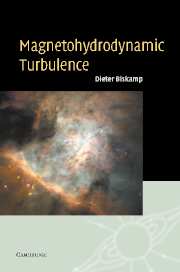Book contents
- Frontmatter
- Contents
- Preface
- 1 Introduction
- 2 Magnetohydrodynamics
- 3 Transition to turbulence
- 4 Macroscopic turbulence theory
- 5 Spectral properties and phenomenology
- 6 Two-point-closure theory
- 7 Intermittency
- 8 Two-dimensional turbulence
- 9 Compressible turbulence and turbulent convection
- 10 Turbulence in the solar wind
- 11 Turbulence in accretion disks
- 12 Interstellar turbulence
- Outlook
- References
- Index
9 - Compressible turbulence and turbulent convection
Published online by Cambridge University Press: 17 August 2009
- Frontmatter
- Contents
- Preface
- 1 Introduction
- 2 Magnetohydrodynamics
- 3 Transition to turbulence
- 4 Macroscopic turbulence theory
- 5 Spectral properties and phenomenology
- 6 Two-point-closure theory
- 7 Intermittency
- 8 Two-dimensional turbulence
- 9 Compressible turbulence and turbulent convection
- 10 Turbulence in the solar wind
- 11 Turbulence in accretion disks
- 12 Interstellar turbulence
- Outlook
- References
- Index
Summary
In the previous chapters turbulence was assumed incompressible. As discussed in Section 2.3, this assumption is valid if either the sonic Mach number of the flow is small, Ms = υ/cs « 1, or the Alfvén Mach number is small, MA = υ/υA « 1. The former condition applies to a weakly magnetized plasma, in which υA « cs, or to motions along the magnetic field, while the latter applies to motions perpendicular to the field. If the flow is turbulent, there is some arbitrariness in the definition of the Mach numbers, since one may choose (a) the mean flow velocity, (b) the r.m.s. velocity fluctuation υ = 〈ῦ2〉1/2 = (Ek)1/2, or (c) the local velocity. Following convention in turbulence theory, we refer to the Mach number in terms of the r.m.s. velocity, noting that local Mach numbers may be considerably higher.
Since laboratory plasmas are usually confined by a strong magnetic field, they can be considered incompressible, the dynamics consisting mainly of cross-field motions. Also the motions in the liquid core of the Earth, which drive the Earth's dynamo, are incompressible, since Ms « 1 (here inertial effects are often neglected altogether, which is called the magnetostrophic approximation). By constrast, most astrophysical plasmas are compressible, for instance the interstellar medium, which is rather cold, such that, in the turbulent motions observed, Ms, and possibly also MA, tend to be large (see Chapter 12), or the turbulence in the interplanetary plasma, which is riding on the supersonic and super-Alfvénic solar wind (Chapter 10).
- Type
- Chapter
- Information
- Magnetohydrodynamic Turbulence , pp. 183 - 216Publisher: Cambridge University PressPrint publication year: 2003



